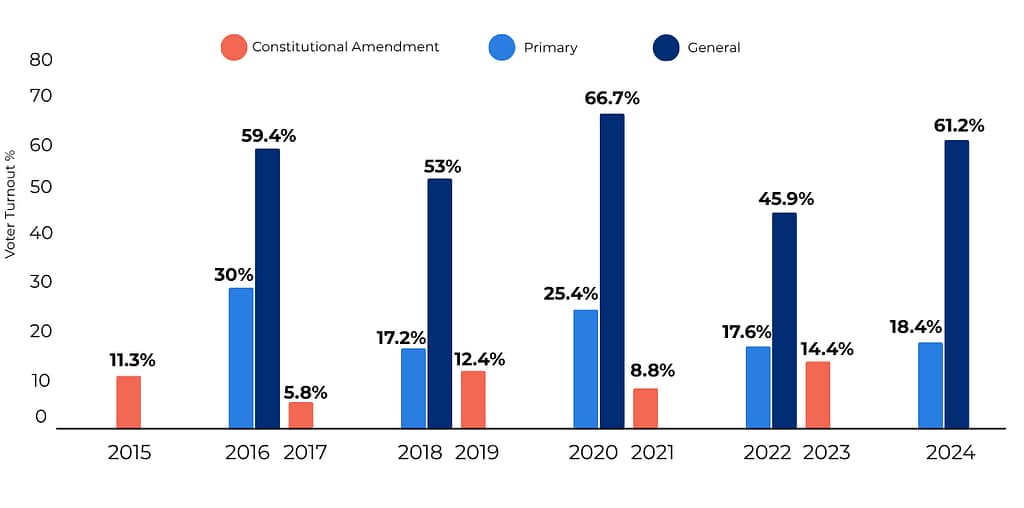When only a few million vote: Constitutional amendment elections
Every odd-numbered year, Texans decide whether to change the state constitution, which shapes everything from how the state government operates to taxes and infrastructure to education and individual rights. Yet only about 1.5 to 2.5 million Texans usually participate in these elections. That limited turnout means a small slice of voters often makes decisions that affect the entire state for decades to come.
Over the past decade, constitutional amendment elections have typically drawn 6-15 percent of registered voters, compared with far higher participation in even-year presidential and gubernatorial primary and general elections. Because so few Texans cast ballots, each vote cast carries greater weight in a constitutional amendment election.
Texas Registered Voter Election Turnout, 2015-24
What Drives or Depresses Turnout
While these elections decide how Texas governs itself at the highest level (often permanently), several factors explain why participation varies so widely in constitutional amendment elections.
Turnout Drivers:
- Ballot interest: Hot-button or high-visibility issues, like property tax relief, water funding, or veterans’ benefits, draw higher turnout.
- Public awareness: Major campaigns or media coverage educate voters on when an election is occurring and what is on the ballot.
- Local elections: When city, school district, or special elections are held on the same day, they can lift participation in select areas of the state.
Turnout Depressors:
- Timing: Odd-numbered November dates lack the momentum of federal or statewide races.
- Ballot complexity: Technical language and amendments addressing administrative tasks tend to disinterest casual voters.
Bottom line: When the ballot feels relevant and visible, Texans show up; when it feels procedural, they don’t.
2023: The High-Turnout Exception
The 2023 constitutional amendment election saw the state’s strongest turnout in a constitutional amendment election since 2005.
What sparked it? With 14 amendments on the ballot, there was an array of widely understood issues that resonated across partisan, age, and geographic lines. This ballot included:
- Proposition 4: A sweeping property-tax cut and homestead exemption increase.
- Proposition 6: Creation of the Texas Water Fund for infrastructure.
- Proposition 8: Funding for rural broadband expansion.
Who Shows Up to Vote?
Because turnout is small in a constitutional amendment election, the electorate looks different from a March primary and a November general election.
Demographics
Voters in constitutional amendment elections skew older and more affluent. Surveys conducted by the University of Houston’s Hobby School show likely voters are overwhelmingly over 50 and more likely to own their homes. In 2023:
- Roughly two-thirds of likely voters were 50 or older.
- Less than 10 percent were under 35.
- Homeowners outnumbered renters 4 to 1.
Geography
Suburban and urban counties consistently post higher participation rates than rural counties. In 2023, Travis County reached roughly 16 percent turnout, which was slightly above the statewide average.
Low Turnout Makes Your Vote Matter More
Because constitutional amendments alter the state’s foundational document, their impact is permanent. Once an amendment passes, it can only be changed through another statewide vote. That permanence makes these elections among the most consequential in Texas politics — even if they attract the fewest voters.
Consider this: the Texas Constitution has been amended more than 500 times, and each change reflects the will of whoever showed up that year. In 2023, even with an unusually high turnout, only about one in seven registered voters helped approve 13 of 14 propositions on the ballot. These decisions shaped property taxes, infrastructure and economic development for years to come.
Low participation means each ballot carries outsized influence. In a general election, your vote is one of millions; in a constitutional amendment election, it might be one of just a few hundred or thousands in your community deciding a statewide policy.
The 2025 constitutional amendment election will take place on Nov. 4. Key dates can be found here.

